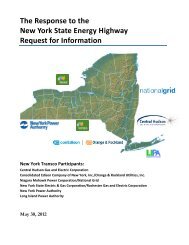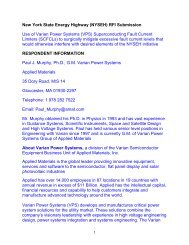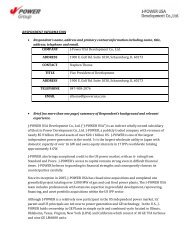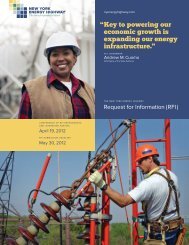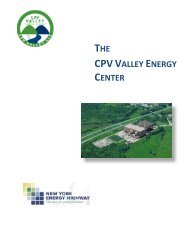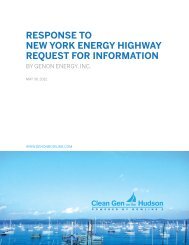Silicon Solution Joint Venture, LLC - Energy Highway
Silicon Solution Joint Venture, LLC - Energy Highway
Silicon Solution Joint Venture, LLC - Energy Highway
Create successful ePaper yourself
Turn your PDF publications into a flip-book with our unique Google optimized e-Paper software.
US SOLAR – WHITE PAPER 24 May 2012<br />
• Lack of standards: In the residential and commercial-scale market, there is a lack of standards<br />
for payments and services. The numerous third-party financiers have different PPA and lease<br />
contracts, and credit quality and maintenance standards. Without standard PPA and lease<br />
agreements throughout the sector, it is difficult to rate and issue solar securities. Geographical<br />
diversity reduces weather-related risk, but it also brings unique regulatory and market risks,<br />
making portfolio evaluation even more difficult. Challenges in bundling assets together may<br />
create a shortage of capacity and cash flow required to arrange and issue a solar bond and<br />
access capital markets.<br />
• Availability of opportunities: Some investors have expressed considerable interest but have<br />
been unable to find suitable investment targets. US solar presents a vast potential market –<br />
from utility-scale plants in the Southwest desert, to greenfield developments in New Jersey to<br />
portfolios of rooftop projects on big-box retail stores across the nation. Yet solar development<br />
options inevitably come with assorted challenges: Southwestern utility-scale markets are<br />
extremely competitive; Northeast US markets are often beset by SREC pricing volatility; many<br />
regions simply do not offer sufficient incentives to make the economics viable; and assembling<br />
meaningful-sized portfolios of projects often comes at steep customer acquisition costs.<br />
Opportunities abound but identifying and executing on them is rarely easy.<br />
4.4. High-liquidity vehicles<br />
The most striking changes in the move from the 'Today' to 'Tomorrow' sides of Figure 15 will only<br />
be possible with the emergence of vehicles that make solar project investments a more liquid<br />
option and that allow these projects to tap a broader pool of investors via the capital markets. The<br />
vehicles identified in the chart are described below.<br />
Bonds can be an at<br />
attractive alternative to<br />
bank loans as they offer<br />
higher liquidity, lessrestrictive<br />
covenants<br />
and lower costs<br />
Project bonds<br />
For debt financing, bonds can be an attractive alternative to bank loans as they offer higher<br />
liquidity (for large issuances with a good rating), less restrictive covenants and lower costs. To<br />
date in the renewables sector, bonds have been used primarily by manufacturing companies<br />
seeking capital for new lines. There have also been a limited number of bonds attached directly to<br />
projects issued by financial institutions or developers.<br />
Bloomberg New <strong>Energy</strong> Finance estimates the clean energy project bond market at $9.6bn<br />
globally with the most conspicuous recent offering being MidAmerican's 550MW Topaz solar<br />
project in February 2012 (see Case Study 5.1 below). Bond issuance for renewable projects has<br />
historically lagged that of the wider infrastructure market, partly due to the sector's relative<br />
immaturity, but also because of the lack of projects large enough to actually issue bonds. Another<br />
traditional barrier to bond floats has been a lack of standards, though there are recent signs of<br />
progress in this area. Rating agencies have grown more adept at assessing solar project risk in<br />
order to grade bonds, and the Climate Bonds Initiative, a non-governmental organisation that<br />
promotes renewable project bonds, is developing standards to determine which project bonds<br />
meet the 'green' criteria.<br />
Asset-backed securities<br />
Securitisation is the process of pooling together contractual debt and selling the resulting assetbacked<br />
securities as notes to institutional investors. Common securitised assets include<br />
payments from mortgage loans, car loans and credit cards (more esoteric examples include<br />
contracts for home burglar alarms, taxi medallions and music royalties).<br />
© Bloomberg New <strong>Energy</strong> Finance 2012<br />
Strictly no copying, forwarding, shared passwords or redistribution allowed without prior written permission<br />
of Bloomberg New <strong>Energy</strong> Finance. For more information on terms of use, please contact<br />
sales.bnef@bloomberg.net. Copyright and Disclaimer notice on page 28 applies throughout. Page 17 of 28



